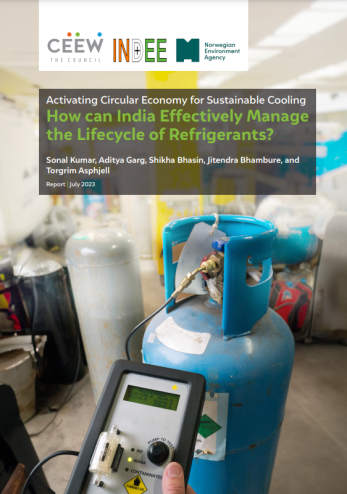Paper
Cooling India with Less Warming
The Business Case for Phasing Down HFCs in Room and Vehicle Air Conditioners
CEEW, NRDC, TERI, IGSD
June 2013 | Sustainable Cooling
Suggested Citation: Council on Energy, Environment and Water, Natural Resources Defense Council, The Energy and Resources Institute, and The Institute for Governance and Sustainable Development. 2013. Cooling India with Less Warming: The Business Case for Phasing-Down HFC’s in Room and Vehicle Air Conditioners. New York: Natural Resources Defense Council.
Overview
This issue paper explores the business case for Indian air conditioning companies to leapfrog and phase down high global warming potential Hydrofluorocarbons (HFCs). It describes methods to move towards a future based on climate-friendly refrigerants and energy-efficient equipment designs. Further, it provides recommendations and an action plan for Indian companies and the government to leapfrog to lower global warming potential (GWP) alternatives.
Read: Why there is a need for Collaborative R&D for Sustainable Cooling in India
Key Highlights
- By 2050, global HFC production and consumption is forecasted to increase five to nine times more than 2010 levels with the largest growth in developing countries.
- India is prone to adverse effects of climate change such as the threat of increased extreme weather events and greater variability in monsoon-fed crops.
- Air conditioning has major impacts on the climate system: the direct emissions of refrigerant greenhouse gases and the indirect emissions from the combustion of fuel to power the equipment.
Projected HFC growth

Source: G.J.M. Velders et al., PNAS, 2009; 106:10949-10954
- HFC use in India can be minimised through the application of regulatory initiatives, resolution of safety concerns with technical standards, service-technician training, and affordable cost achieved through economies of scale.
- India’s Bureau of Energy Efficiency (BEE) works on improved energy efficiency standards for room air conditioners under a mandatory standards and labelling programme.
- Most Indian companies have reported that they are planning to change from HCFC-22 refrigerant to HFC-410a (a blend of HFC-125 and HFC-32), which has a GWP of 2088.
- A major challenge in India is to coordinate the schedules of the HCFC phase-out and the upgrades in energy efficiency and energy-labeling standards with the local availability of next-generation technology at an affordable cost.
- There are three viable refrigerant options to replace HFC-134a in automobiles: HFO-1234yf, HFC-152a, and CO2.
- The government has allowed companies to choose the technology they will use to replace HFCs and HCFCs while encouraging voluntary decisions to further protect the climate.
Key Recommendations
- Endorse the EC flammable safety standard as an interim measure while facilitating rapid development of Indian safety standards.
- Commit to producing low-GWP, better life-cycle climate performance, room air conditioners for green buildings, including apartments and condominiums. Also, the government of India could signal the endorsement of LCCP for appropriate applications.
- Promote HC-290 room air conditioners amongst governments and non-governmental organisations concerned with climate change. This would reward companies such as Godrej, whose domestic sale depends on the confidence that these systems are safe.
- Indian market could drive further if African and Asian countries that import Indian vehicles adopt provisions similar to EU vehicle air-conditioning directives.
- Transition to lower-GWP refrigerants to bring HFO-1234yf to world-scale production for mobile air conditioners with lower competitive prices. It would also transform the manufacturing of room air conditioners in China, India, Korea, Thailand, and other countries.
HFC use in India can be minimised through the application of regulatory initiatives, resolution of safety concerns with technical standards, service-technician training, and affordable cost achieved through economies of scale.







